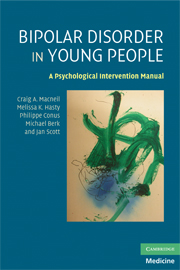Book contents
- Frontmatter
- Contents
- Preface
- Acknowledgements
- Introduction
- 1 Bipolar disorder
- 2 Assessment and engagement
- 3 Insight, adaptation, and functional recovery
- 4 Medication adherence
- 5 Cognitive behavioral therapy interventions
- 6 Social rhythm regulation
- 7 Relationship issues and family work
- 8 Alcohol, substance abuse, and other comorbid disorders
- 9 Identifying early warning signs, preventing relapse, and termination of therapy
- Appendices
- References
- Index
9 - Identifying early warning signs, preventing relapse, and termination of therapy
Published online by Cambridge University Press: 06 July 2010
- Frontmatter
- Contents
- Preface
- Acknowledgements
- Introduction
- 1 Bipolar disorder
- 2 Assessment and engagement
- 3 Insight, adaptation, and functional recovery
- 4 Medication adherence
- 5 Cognitive behavioral therapy interventions
- 6 Social rhythm regulation
- 7 Relationship issues and family work
- 8 Alcohol, substance abuse, and other comorbid disorders
- 9 Identifying early warning signs, preventing relapse, and termination of therapy
- Appendices
- References
- Index
Summary
Prodromal symptoms before manic depressive relapses show considerable variation in their nature and timing between individuals … Prodromal symptoms, however, are consistent within individuals giving them a predictive value for each patient.
Perry et al. (1995, p. 405–6)Research indicates that between 70% and 90% of people with bipolar disorder will have more than one episode (Keller et al.,1993; Gitlin et al., 1995; Tacchi & Scott, 2005), with naturalistic studies showing that around 49.8% of people will relapse within a year, and 68% within 2 years (Silverstone et al., 1998; Lam & Wong, 2005). Amongst those who relapse, two-thirds will have multiple relapses, with 9 being the mean number of episodes (Keller et al., 1993; Gitlin et al., 1995). Given these high rates of relapse in bipolar disorder, work on relapse prevention remains an essential aspect of psychological intervention for this population.
It is encouraging that there often appear to be signs or symptoms which occur before a person becomes symptomatic, with early identification of these providing an opportunity to intervene and prevent relapse. There is also evidence that about 75% of people with bipolar disorder are themselves able to reliably identify their prodromal symptoms for both mania and depression (Jackson et al., 2003), even following a first episode (Ward et al., 2003). In their randomized treatment trial, Perry et al. (1995) found that most of the trial participants had identifiable early signs, which began between two and four weeks prior to a manic or depressive relapse.
- Type
- Chapter
- Information
- Bipolar Disorder in Young PeopleA Psychological Intervention Manual, pp. 131 - 146Publisher: Cambridge University PressPrint publication year: 2009

